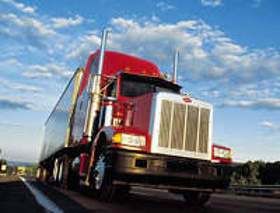Driving In The N.E. ?
Topic 10619 | Page 1
My dad loved driving the Northeast and staying ou months at a time. I think its a to each his own kinda deal. Best thing I can say is to know thyself so im doing no touch dry van , midwest regional short runs with home every friday.
Regional:
Regional Route
Usually refers to a driver hauling freight within one particular region of the country. You might be in the "Southeast Regional Division" or "Midwest Regional". Regional route drivers often get home on the weekends which is one of the main appeals for this type of route.
Dry Van:
A trailer or truck that that requires no special attention, such as refrigeration, that hauls regular palletted, boxed, or floor-loaded freight. The most common type of trailer in trucking.Floyd, the truth is that you will go where you're dispatched to. There are a lot of people in the Northeast, and therefore a lot of trucks. It is tough - I run up into Connecticut from Louisiana almost on a weekly basis. I run a dedicated flat-bed account that has several customers up in that area. I've been doing it a while now, so I've gotten accustomed to the challenges. There is one town I regularly go to that was established in the late 1600's! Their streets are very tough to commandeer in a big truck.
The key to success up in that area is timing. You don't cross the George Washington bridge at eight in the morning - you plan your trip so that you are going through the Bronx at one or two in the morning. I have considerable success in the Northeast, but you have to plan ahead and have your secret little places that you can find parking.

Farthest I've gone is Mass. It wasn't bad, though it was pretty bleak at 7am. Some cities you avoid at certain times of day. I drive through Chicago frequently, and never go through it unless I know traffic, crash locations, and have at least 4 hours on the clock. It might take three miles to merge into another lane simply because it's a bad place to be during rush-hour.
Also, I don't think I've ever seen Milwaukee during the day. I always hear about the bad traffic, but I've got my foot down the whole way because I check my hours way in advance.

I dont think the northeast is all that bad the biggest problem is the lack of parking. I have to take this load up to maine and im hopeing i can make it to one of the turnpike service plazas before i run out of time. Then friday i deliver to one place go to the other to pick up my return load and hopefully make it back to pa before i run out of hours.

Some of us aren't so lucky to be able to trip plan around certain hours of the day. But then again, I'm not complaining about it since I love my job! Running linehaul in LTL , I run according to a pre-determined schedule. Since I'm currently on a day schedule, sometimes I have to go to Brooklyn in the middle of the day. I've spent 45 minutes at a traffic light in Brooklyn, just waiting for my turn to make a left hand turn. I've already gotten caught on the BQE (Brooklyn Queens Expressway) during rush hour. When making runs up to Connecticut from PA, coming back I've been on 95 going from Connecticut through NY during rush hour.
Believe it or not .... you get used to it. But oh what a difference night time brings to the roads!
Those low bridges will be in your Rand McNally atlas. Google Maps is also your friend.
If you can run comfortably in the NE, you can run anywhere. It does get easier after a while.
LTL:
Less Than Truckload
Refers to carriers that make a lot of smaller pickups and deliveries for multiple customers as opposed to hauling one big load of freight for one customer. This type of hauling is normally done by companies with terminals scattered throughout the country where freight is sorted before being moved on to its destination.
LTL carriers include:
- FedEx Freight
- Con-way
- YRC Freight
- UPS
- Old Dominion
- Estes
- Yellow-Roadway
- ABF Freight
- R+L Carrier
Linehaul:
Linehaul drivers will normally run loads from terminal to terminal for LTL (Less than Truckload) companies.
LTL (Less Than Truckload) carriers will have Linehaul drivers and P&D drivers. The P&D drivers will deliver loads locally from the terminal and pick up loads returning them to the terminal. Linehaul drivers will then run truckloads from terminal to terminal.HOS:
Hours Of Service
HOS refers to the logbook hours of service regulations.
Those low bridges will be in your Rand McNally atlas. Google Maps is also your friend.
I would definitely be careful with Google Maps though. I used to use it a lot and it doesn't get updates very often and sometimes it takes you on routes that are being worked on or closed due to construction or to destinations that no longer exist or sometimes it won't take you directly to the destination but instead to somewhere close to it. Like, I was looking for a Fuddrucker's and it took me to the nearest one.....which had been closed for the last 3 years. Or when I was working as a Flex officer, and I had to go to a new account like every day and it took me to a burger king and insisted that I was at Kinder Morgan. I then put in the address instead of the company name to see if it fared any better, and it insisted the address of the BK was the address I had typed in, which it was not (it wasn't even remotely similar lol).
And these are just troubles it was having with me being in a car, so I imagine it must be worse for a truck. There are no options to say that you are driving a truck, so it will obviously assume you are driving a car, and take you on routes that are for cars, with low bridges, no truck routes, no room to turn around, etc. I would not call Google Maps my 'friend' when truck driving. The Rand McNally yes, because it has truck driving routes in it.
HOS:
Hours Of Service
HOS refers to the logbook hours of service regulations.
I've driven a lot up to Maine, Mass and Connecticut and honestly i havn't had any trouble with low bridges but more problems with tight turns. Word of advice is to get your tandems as far forward as you legally can while driving up there, it makes a huge difference to keep from hitting things haha
Tandems:
Tandem Axles
A set of axles spaced close together, legally defined as more than 40 and less than 96 inches apart by the USDOT. Drivers tend to refer to the tandem axles on their trailer as just "tandems". You might hear a driver say, "I'm 400 pounds overweight on my tandems", referring to his trailer tandems, not his tractor tandems. Tractor tandems are generally just referred to as "drives" which is short for "drive axles".
Tandem:
Tandem Axles
A set of axles spaced close together, legally defined as more than 40 and less than 96 inches apart by the USDOT. Drivers tend to refer to the tandem axles on their trailer as just "tandems". You might hear a driver say, "I'm 400 pounds overweight on my tandems", referring to his trailer tandems, not his tractor tandems. Tractor tandems are generally just referred to as "drives" which is short for "drive axles".

I would not call Google Maps my 'friend' when truck driving. The Rand McNally yes, because it has truck driving routes in it.
Yes, Google Maps shouldn't be used as a navigation device for trucks - that goes without saying. Google Maps is your friend when you can zoom into destinations and see the geography, i.e. street intersections, parking availability, landmarks when navigating your final few miles. Google Maps has been more valuable to me than the RM Atlas, but I use them both.
Dm:
Dispatcher, Fleet Manager, Driver Manager
The primary person a driver communicates with at his/her company. A dispatcher can play many roles, depending on the company's structure. Dispatchers may assign freight, file requests for home time, relay messages between the driver and management, inform customer service of any delays, change appointment times, and report information to the load planners.New Reply:
New! Check out our help videos for a better understanding of our forum features

















Preview:








 TT On Facebook
TT On Facebook
So, I'm in Michigan, and there is a program through the state that will help pay for CDL school if you meet certain requirements. While in "class" today, the instructor viehimately stated "stay out of the north east! Even veteran drivers won't drive there! It has lots of low bridges!" Is this true? Is it really THAT bad? I've never been, but I'm sure traffic would a headache & streets are said to be narrow... but never go there? How do they eat if no trucks go there? Lol
CDL:
Commercial Driver's License (CDL)
A CDL is required to drive any of the following vehicles:
DAC:
Drive-A-Check Report
A truck drivers DAC report will contain detailed information about their job history of the last 10 years as a CDL driver (as required by the DOT).
It may also contain your criminal history, drug test results, DOT infractions and accident history. The program is strictly voluntary from a company standpoint, but most of the medium-to-large carriers will participate.
Most trucking companies use DAC reports as part of their hiring and background check process. It is extremely important that drivers verify that the information contained in it is correct, and have it fixed if it's not.